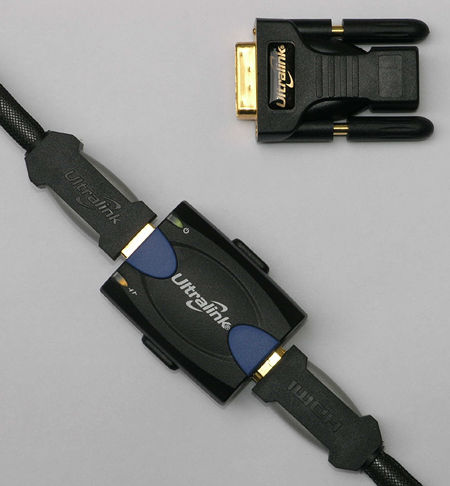Ultralink HDMI-RPT HDMI Repeater

A few manufacturers claim that something about the design of their DVI/HDMI cables makes them usable in longer lengths. That may be true; we haven't tested these cables. The length of DVI/HDMI cables I typically use for my projector reviews is 5 meters between the source and the display. If a switcher or processor is in the path, add another 2 meters from the source to the processor.
But these lengths are not adequate for all installations, and if I had a projector permanently mounted on the ceiling, they wouldn't be enough for me, either. And what about the custom installer who must run cables through walls, which nearly always requires more cable than a direct, external run?
There are several options for these needs. One is fiber-optic conversion. Some manufacturers (notably SIM2) use this for their projector and outboard switch box combinations, but it is not a readily accessible alternative for the average consumer.
Another option is a cable extender, which boosts the signal somewhere along its length. Runco makes the LiveLink, which accepts a standard HDMI connector at its input and has a captive pigtail at the output terminated in a standard DVI plug for connection to the projector. The LiveLink can support lengths up to 75 feet and is rated for 720p and 1080i sources.
Ultralink to the Rescue
We haven't yet tested the Runco extender. It's possible that it will exceed the specifications, but consumer 1080p sources are currently as rare as orthodontists for chickens, so it isn't straightforward to test a repeater at 1080p. Fortunately, another HDMI extender, the Ultralink HDMI-RPT, flew over my transom at the same time I was testing two 1080p projectors, the Fujitsu LPF-D711W LCD and the Faroudja DILA1080pHD.
Ultralink also sent along two very long samples of their HDMI cables, one of them 15 meters (about 49 feet) and the other 12 meters (just over 39 feet), along with two HDMI-to-DVI adapters. Both the cables and adapters were extremely well made, and they fit into each other with just the right tension, neither too loose nor too tight.
I did note two downsides: the thumbscrews on the adapters that lock them securely into DVI jacks were tedious to tighten and loosen, and the cables were relatively stiff and, at these long lengths, all too eager to tangle themselves up. Both of these issues are nuisances for reviewers and videophiles who change things around constantly, but they are nearly irrelevant for a set-and-forget installation.
The main story here is the Ultralink HDMI-RPT repeater. As you can see from the photograph, there's not much to it: an HDMI input and an HDMI output, plus two status lights to indicate proper performance. It's so small, it resembles nothing more than a carbuncle growing out of the cable. As with the Runco repeater, the Ultralink draws power from the source signal and requires neither an AC connection nor batteries.
The only significant recommendation in the instructions was that the cable on the repeater's output side be shorter (or at least no longer) than the cable at its input, and that neither be longer than 20 meters (just over 65 feet). The repeater can also be used with a number of computer resolutions (see the Specifications section) but I tested it only with video sources. All testing was performed with 1080p processed sources, the repeater will prove just as useful for those with lower-resolution displays and sources, including 1080i and 720p.
Testing, Testing. . .
I started with the Fujitsu projector. First, I wanted to see what would happen with a long HDMI cable without the repeater, so I connected a Pioneer DV-59AVi DVD player, configured to upconvert DVDs to 720p, from its HDMI output to the HDMI input of the Fujitsu's separate AV Selector, where all the projector's inputs are located. The AV Selector performs all the required deinterlacing and upscaling, converting all sources to 1080p before sending them to the projector via another digital video cable.
I ran the 15-meter Ultralink HDMI cable directly from the AV Selector to the projector. I got a signal, all right, overlaid with hundreds of nasty vertical red and blue stripes that rendered the image unwatchable. I then removed the HDMI plug at the projector end and inserted it into the Ultralink repeater. Then I ran a short, 2-meter cable from the output of the repeater to the projector.
Eureka! I saw the same beautiful image I've been enjoying with that projector for months, with no visible degradation. Not only that, when I swapped out that 2-meter repeater-to-projector cable for the 12-meter Ultralink HDMI cable, I got the same superb image. The total digital cable length from DVD player to projector was now 29 meters (counting the cable from the player to the Selector), or about 95 feet.
And if that wasn't enough, when I fed a native 720p high-definition source into the system (from Digital Video Essentials on D-VHS), which was also upscaled to 1080p by the AV Selector, the image remained as good as it had been with my normal direct 5-meter run, whether I watched regular program material or test patterns.
I'll make the rest of the story short. The Ultralink HDMI-RPT repeater performed just as well with the Faroudja projector (review in progress) driven from the Faroudja DVP-4000 video processor/DVD player. I set the DVP-4000 to upscale DVDs and other input sources to 1080p/60. The Ultralink repeater did nothing to visibly degrade the image, nor were there any added artifacts or noise from either DVDs or 720p D-VHS material.
Conclusion
This is an easy call. Not all of our readers need a long digital-video cable run in their system. But if you do, the Ultralink HDMI-RPT repeater is a sure ticket to getting the performance you paid for from your video display.
Addendum
Based on information from good sources, I've stated in the past that HDMI is not capable of carrying 1080p/60. Considering the results here, it apparently is. I'll take cranberry sauce with my crow, thank you, with a nice helping of cornbread stuffing on the side.
Highs and Lows
High
•Gets the job done with no fuss
Lows
•Nothing





























































